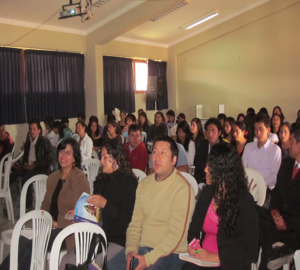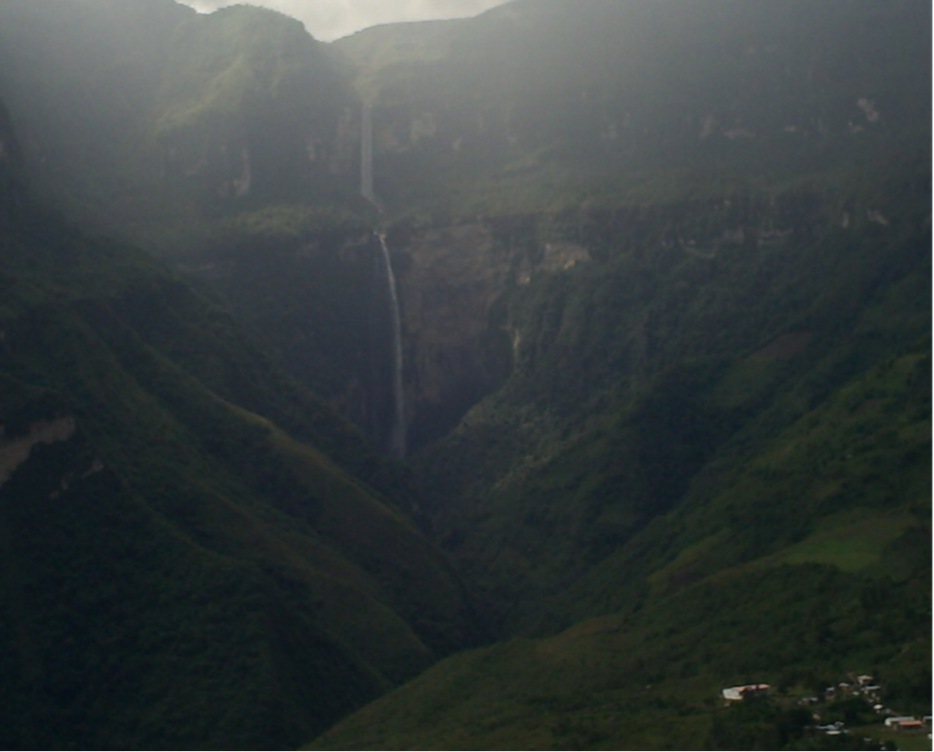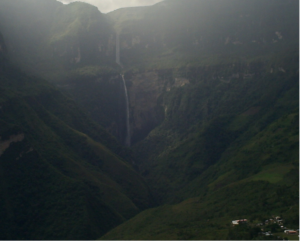by Dr Malayna Raftopoulos, ILAS Stipendiary Fellow 2013-14
On 1 March 2006 the municipality of Chachapoyas held a press conference to publically announce one the world’s highest waterfalls, Gocta, measured at 771 metres. The ‘discovery’ of the waterfall, by the German engineer Stefan Ziemendorff, put a previously isolated and forgotten village in the Utcubamba valley on the map. One and half hours (21km) from the city of Chachapoyas, the small rural annex of Cocachimba is the main point of entry to the waterfall. What makes this area so spectacular is its extraordinary beauty; the endless steep mountain ranges and deep canyons cast an enchanting spell on the eye. Also known as La Chorrera, which comes from the sound made by the yellow tailed woolly monkey, the waterfall feeds the river that forms the boundary between the two villages of Cocachimba and San Pablo. Its close proximity to the Amazon jungle and Andean mountain ranges makes this area rich in biodiversity. Birds and animals native to Peru, such as the Speckle Chested bird, are only found in the cloud forests between the regions of Amazonas and San Martín, the Emerald Toucanet and the Andean Cock of the Rock, Peru’s national bird, inhabit the forests adjoining the village.
Leaving the Olmos-Bagua highway descending from the city of Chachapoyas, a large billboard mounted at the side of the road signals the turn off for Gocta and greets tourists as they begin their ascent to Cocachimba. Put in place by the Regional Government of Amazonas, the sign demonstrates the new focus on peripheral tourism, promoting visits to picturesque rural villages and scenic landscapes. Conjuring up images of a village isolated for centuries, hidden deep in the thick cloud forests, wild and undiscovered, Cocachimba has captured the imagination of travellers and has become an attraction for those seeking authenticity and interested in nature-based tourism. It was this small village, of around 200 residents, that formed the main focus of my doctoral research into sustainable tourism development. Embracing the sustainable tourism mantle, the local, regional and national governments were keen for tourism development in Cocachimba to be seen in a sustainable light. Using a ‘bottom up’ approach, the discourse of sustainable tourism promotes the idea of maximising the potential of tourism by devising appropriate strategies in cooperation with all major groups and local communities. With an emphasis on community participation, this development strategy seeks to enhance local involvement while promoting economic, social and cultural well-being. Given that development is often the main goal or justification for developing or pursuing tourism, questioning the principles and validity of sustainable tourism as a development model is an important issue to address.
 Having spent eighteen months conducting research in Cocachimba and the city of Chachapoyas, I was delighted to receive an invitation from the Faculty of Tourism at the National University of Toribio Rodriguez de Mendoza to present the research undertaken as part of my PhD. Travelling back to Chachapoyas to discuss my findings invoked many wonderful memories of the time I spent in the field. Students, lecturers and employees from both the public and private sector were invited to the presentation entitled ‘Examining the Principles of Sustainable Tourism’. Using Cocachimba as a case study, the research questioned the validity of sustainable tourism as a development model. More specifically, it contested the notion that its principles could be successfully applied at micro level. With more than 50 people attending the talk and refreshments kindly provided by the Institute of Latin American Studies, the event was a great success an enjoyable experience for all those who attended.
Having spent eighteen months conducting research in Cocachimba and the city of Chachapoyas, I was delighted to receive an invitation from the Faculty of Tourism at the National University of Toribio Rodriguez de Mendoza to present the research undertaken as part of my PhD. Travelling back to Chachapoyas to discuss my findings invoked many wonderful memories of the time I spent in the field. Students, lecturers and employees from both the public and private sector were invited to the presentation entitled ‘Examining the Principles of Sustainable Tourism’. Using Cocachimba as a case study, the research questioned the validity of sustainable tourism as a development model. More specifically, it contested the notion that its principles could be successfully applied at micro level. With more than 50 people attending the talk and refreshments kindly provided by the Institute of Latin American Studies, the event was a great success an enjoyable experience for all those who attended.



Recent Comments